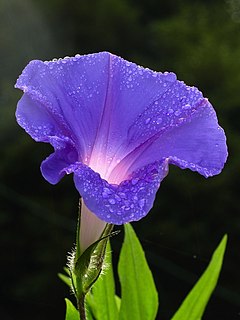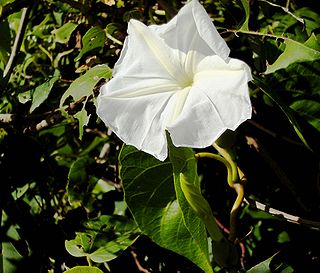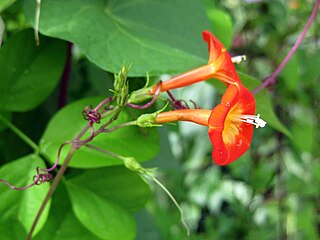
Morning glory is the common name for over 1,000 species of flowering plants in the family Convolvulaceae, whose current taxonomy and systematics are in flux. Morning glory species belong to many genera, some of which are:

Ipomoea is the largest genus in the plant family Convolvulaceae, with over 600 species. It is a large and diverse group, with common names including morning glory, water convolvulus or water spinach, sweet potato, bindweed, moonflower, etc. The genus occurs throughout the tropical and subtropical regions of the world, and comprises annual and perennial herbaceous plants, lianas, shrubs, and small trees; most of the species are twining climbing plants.

Ipomoea aquatica, most widely known as water spinach, is a semi-aquatic, tropical plant grown as a vegetable for its tender shoots. I. aquatica is generally believed to have been first domesticated in Southeast Asia. It is widely cultivated in Southeast Asia, East Asia, and South Asia. It grows abundantly near waterways and requires little to no care.

Ipomoea alba, sometimes called the tropical white morning-glory or moonflower or moon vine, is a species of night-blooming morning glory, native to tropical and subtropical regions of North and South America, from Argentina to northern Mexico, Arizona, Florida and the West Indies. Though formerly classified as genus Calonyction, species aculeatum, it is now properly assigned to genus Ipomoea, subgenus Quamoclit, section Calonyction.

Ipomoea purpurea, the common morning-glory, tall morning-glory, or purple morning glory, is a species in the genus Ipomoea, native to Mexico and Central America.

Ipomoea violacea is a perennial species of Ipomoea that occurs throughout the world with the exception of the European continent. It is most commonly called beach moonflower or sea moonflower as the flowers open at night.

Ipomoea pes-caprae, also known as bayhops, bay-hops, beach morning glory or goat's foot, is a common pantropical creeping vine belonging to the family Convolvulaceae. It grows on the upper parts of beaches and endures salted air. It is one of the most common and most widely distributed salt tolerant plants and provides one of the best known examples of oceanic dispersal. Its seeds float and are unaffected by salt water.

Ipomoea cairica is a vining, herbaceous, perennial plant with palmate leaves and large, showy white to lavender flowers. A species of morning glory, it has many common names, including mile-a-minute vine, Messina creeper, Cairo morning glory, coast morning glory and railroad creeper. The species name cairica translates to "from Cairo", the city where this species was first collected.

Ipomoea indica is a species of flowering plant in the family Convolvulaceae, known by several common names, including blue morning glory, oceanblue morning glory, koali awa, and blue dawn flower. It bears heart-shaped or 3-lobed leaves and purple or blue funnel-shaped flowers 6–8 cm (2–3 in) in diameter, from spring to autumn. The flowers produced by the plant are hermaphroditic. This plant has gained the Royal Horticultural Society's Award of Garden Merit.

Ipomoea pandurata, known as man of the earth, wild potato vine, manroot, wild sweet potato, and wild rhubarb, is a species of herbaceous perennial vine native to North America. It is a twining plant of woodland verges and rough places with heart-shaped leaves and funnel-shaped white flowers with a pinkish throat. The large tuberous roots can be roasted and eaten, or can be used to make a poultice or infusion. When uncooked, the roots have purgative properties.

Ipomoea asarifolia, the ginger-leaf morning-glory, is a species of plant in the family Convolvulaceae, of the genus Ipomoea.

Ipomoea nil is a species of Ipomoea morning glory known by several common names, including picotee morning glory, ivy morning glory, and Japanese morning glory. It is native to the tropical Americas, and has been introduced widely across the world.

Amphicarpaea bracteata is an annual to perennial vine in the legume family, native to woodland, thickets, and moist slopes in eastern North America.

Ipomoea carnea, the pink morning glory, is a species of morning glory that grows as a bush. This flowering plant has heart-shaped leaves that are a rich green and 6–9 inches (15–23 cm) long. It can be easily grown from seeds. These seeds are toxic and it can be hazardous to cattle; the toxicity is related to the swainsonine produced by its endophytes, and to bioaccumulation of selenium in the leaves but mostly in the seeds.

Ipomoea coccinea is a flowering plant in the family Convolvulaceae known by several common names including red morning glory, redstar and (ambiguously) Mexican morning glory.

Ipomoea lacunosa, the whitestar, white morning-glory or pitted morning-glory, is a species that belongs to the genus Ipomoea. In this genus most members are commonly referred to as "morning glories". The name for the genus, Ipomoea, has root in the Greek words ips and homoios, which translates to worm-like. This is a reference to the plant's vine-like growth. Lacunosa comes from a Latin word meaning air spaces, correlating with the venation of the leaves. Ipomoea lacunosa is native to the United States and grows annually. The flowers of this species are usually white and smaller than most other morning glories.
Phyllonorycter ipomoellus is a moth of the family Gracillariidae. It is found in south-western Rwanda in open clearings in montane wet forests at an altitude of about 1,800 meters.

Ipomoea oenotherae is a species of plant of the morning glory genus, Ipomoea, in the family Convolvulaceae. It derives its name from the resemblance it bears to plants in the genus Oenothera. Ipomoea oenotherae is a succulent and a cryptophyte.

















